

|
| weblog/wEssays archives | home | |
|
Who Gets Hammered in the 2007 Housing Bust: the Lower Middle Class (June 21, 2006) 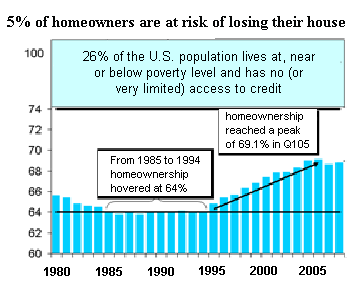 A great con has been played on the most vulnerable aspirants to the American Dream--those
striving mightliy to join the middle class. Just buy a house, the doctrinaire pitch
has it, and soon, thanks to rising housing prices, you'll have equity and thus some
measure of wealth. After all, house values never drop, they only rise.
A great con has been played on the most vulnerable aspirants to the American Dream--those
striving mightliy to join the middle class. Just buy a house, the doctrinaire pitch
has it, and soon, thanks to rising housing prices, you'll have equity and thus some
measure of wealth. After all, house values never drop, they only rise.
Only there was one little problem: millions of households didn't have the traditional 20% down payment--a standard which became ever more unattainable as housing prices exploded. The wonderful folks in the mortgage lending industry, with help behind the curtains from Federal regulators, came up with a solution: an exotic stew of hybrid mortgages, mortgages which required no down payment, and indeed, no payments of principal. Virtually everyone who wasn't in prison and who had a job above minimum wage could now buy into the American Dream. 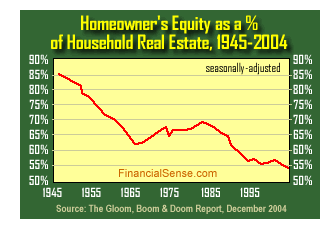 But as I have detailed here (Foreclosures:
How Bad Will It Get?), these late-comers to the great "join the middle class through
homeownership" party will most likely lose their tenuous hold on their houses.
(Also see (Foreclosures Part II.)
But as I have detailed here (Foreclosures:
How Bad Will It Get?), these late-comers to the great "join the middle class through
homeownership" party will most likely lose their tenuous hold on their houses.
(Also see (Foreclosures Part II.)
But hasn't the great housing boom fueled a heady rise in home equity, lifting all boats? Apparently not. This chart reveals that homeowner equity has dropped even as housing prices rose. Wait a minute; housing prices have certainly risen, so where's the equity? We all know the answer: it's been borrowed and spent. 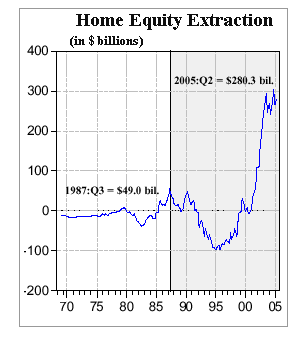 As this chart demonstrates, the extraction of home equity--some $4 trillion by most accounts--has
been spectacularly unprecedented. Clearly, this is not confined to the bottom 5% of
homeowning households; those poor souls barely enjoyed the heady rise in equity before it
started falling.
As this chart demonstrates, the extraction of home equity--some $4 trillion by most accounts--has
been spectacularly unprecedented. Clearly, this is not confined to the bottom 5% of
homeowning households; those poor souls barely enjoyed the heady rise in equity before it
started falling.
So who extracted $4 trillion in equity? The great middle class, of course. The equity was especially tempting to the lower middle class--the folks who are being squeezed by flat wages and rising inflation. As this chart shows, American homeowners are no longer sitting on paid-in-full homes; they're sitting on heavily leveraged mortgages they've taken out. And a significant percentage of those mortgages are now adjustable, meaning they will re-set to higher rates over the next few years: Adjustable-rate mortgages now account for a quarter of the more than $8.5 trillion in outstanding loans, according to the Mortgage Bankers Association of America. "We're talking about potentially 2 to 3 trillion dollars of mortgages being these adjustable rates that are going to come due to reset in the next 18 to 24 months," said Rick Sharga, vice president of RealtyTrac Inc., a database on foreclosure properties. 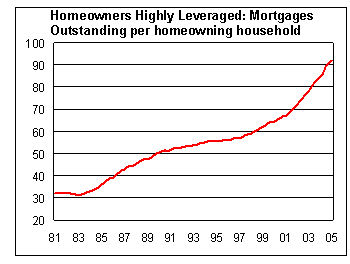 The housing cheerleaders like to spout numbers which mask the enormity of this
leveraged debt; for example, "only 4% of mortgages will re-set to higher rates in 2006."
But the problem isn't just with these marginalized borrowers; it's with everyone who
borrowed heavily against their equity in lieu of savings.
The housing cheerleaders like to spout numbers which mask the enormity of this
leveraged debt; for example, "only 4% of mortgages will re-set to higher rates in 2006."
But the problem isn't just with these marginalized borrowers; it's with everyone who
borrowed heavily against their equity in lieu of savings.
The central conceit at the heart of the housing cheerleaders' rosy view is exceedingly heartless: yes, a bunch of people will lose their homes, but they couldn't afford them anyway. But the problems of "the little people," the cheerleaders say, won't affect all of us solid middle-class homeowners who bought long ago; we're safely sitting on tons of equity. 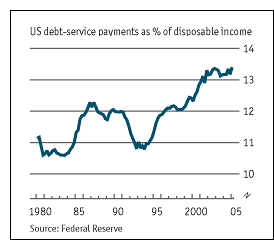 Really? Then why has home equity been shrinking for years? (see chart above) The reason
is obvious: American households have indulged in a borrowing spree without precedent.
Really? Then why has home equity been shrinking for years? (see chart above) The reason
is obvious: American households have indulged in a borrowing spree without precedent.
This quasi-rosy view--sure, some households will get hammered by the recession, but the "rest of us" will be unaffected--is encapsulated in this report from the FDIC which predicted the recession would take down the 10% of U.S. households who are overleveraged: Scenarios for the Next U.S. Recession. The cheerleaders are missing one key point. The collapse of the housing bubble won't just take out an isolated 10% of households; it will take them out first and then move down the economic chain in domino-like fashion. Sure, it will be the maid and her mechanic husband who lose their home first, but then the carpenter and the mortgage broker will lose their jobs, and some of them will lose their homes, too. As the capital gains and transfer tax revenues dry up, then the municpalities which have been counting on that revenue to make payroll will have to slash heretofore sacrosanct government positions. 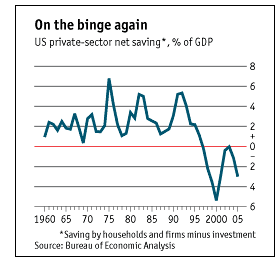 The dominoes don't stop there, of course; as housing prices fall under the weight of
foreclosures and fire sales by desperate "investors," those middle-class households who
thought they were safe leveraging "only" 80% of the value of their home will wake up and find
a 20% decline in home values has wiped out their equity. Now, when they have to sell, due
to the usual litany of life's woes--job transfers, divorce, medical emergencies, etc., they
will discover they have negative equity: their mortgage is larger than the value of their house.
The dominoes don't stop there, of course; as housing prices fall under the weight of
foreclosures and fire sales by desperate "investors," those middle-class households who
thought they were safe leveraging "only" 80% of the value of their home will wake up and find
a 20% decline in home values has wiped out their equity. Now, when they have to sell, due
to the usual litany of life's woes--job transfers, divorce, medical emergencies, etc., they
will discover they have negative equity: their mortgage is larger than the value of their house.
As this chart shows, traditional savings has fallen to a negative number. People have been perceiving their equity as "savings," and have "taken off some of the cream" as their "savings/equity" has risen by leaps and bounds. Now that their "savings account/equity" has started to decline, withdrawals are no longer possible for those who have already extracted most of their equity via re-finances and lines of credit. As I highlighted yesterday, it isn't the top 10% of households who will suffer in the 2007 housing bust recession. They control over 2/3 of the private wealth of the nation (see below for the link to a Wall Street Journal story.) No, it's the 50% of households whose share of national wealth is a meager 2.5%. That 50% comes to about 150 million people. You do see where this is going, don't you? A political revolution is brewing. Not a violent revolution, of course, but one fueled by the catastrophic loss not just of whatever small capital those 150 million people (half of our nation's population of 300 million) might have acquired, but more importantly, perhaps, the loss of their belief in the American Dream--of home ownership and a life of luxury paid for by painless extraction of ever-rising equity. Whether you like it or not, or if it fits your ideological bias, the truth is: there is an "us" and "them" in America. As The Economist pointed out in The Rich, the Poor, and the Growing Gap Between Them, income disparity is larger in the U.S. than in any other industrialized nation. Meanwhile the cheerleaders write tripe like this: Why The Slowdown Won't Become A Slump. The cheerleaders always make one key assumption: the poor dumb lower-middle class (what we used to call the working class) folks can lose their homes and livelihoods, but "we" will be protected by our fat equity and our plush middle-class jobs. Well, don't count on it, buster. The equity slide has a long way to go, and every 10% down will take more "middle class" households' wealth with it. And don't be so sure your job is safe; when the 10% of the workforce which depends on housing gets decimated, don't you think there will be an effect on retail, banking, restaurants, government, and indeed, on every sector of the economy? By December 2007, the cheerleaders' pom-poms will be bedraggled, and their rahs-rahs dispirited as the ugly specter of class warfare darkens their perpetually rosy view of leverage, debt and financial disparity. 30 million Americans, those in the top 10%, will be cushioned by their 2/3 share of the $50 trillion in total U.S. household assets; 150 million will have no assets, only debts, and the 120 million in between will be watching their share of the pie dwindle as housing values notch ever downward and unemployment notches ever upward. A recipe for rosiness? I think not. For more on this subject and a wide array of other topics, please visit my weblog. copyright © 2006 Charles Hugh Smith. All rights reserved in all media. I would be honored if you linked this wEssay to your site, or printed a copy for your own use. |
||
| weblog/wEssays | home |